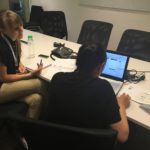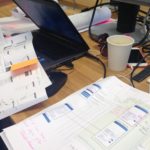During my Master’s Honors Academy I had the opportunity to follow seven different modules given for the USI program.

The USI program is a Professional Doctorate in Engineering (PdEng) focused on user-centered design methodologies, with the aim of improving the interaction between people and systems and to make technology truly accessible and beneficial for all people.
The program is characterized by its focus on design, practical training, teamwork and cross-cultural and international orientation. The trainees come from different disciplines, with backgrounds in behavioral sciences, design and (software) engineering.
The modules are given by external experts, the are normally one week long, and they are characterized by intense workflow rhythm. Every module requires good skills of teamwork and high flexibility in the workflow. Normally modules are structured with the expert providing lectures on the topic and giving a task to be completed by the end of the week. The final work has to be presented in front of the group and related people, and the final presentation is also a moment of feedback from the group on the work done.
During the two years, I had the opportunity to follow these modules with the group:
- Business Modeling Design;
- Statistics and Quantitative Data Analysis;
- Web Analytics;
- Strategies for Usability Testing;
- Crowdsourcing;
- People and Design Research;
- Contextual Task Analysis.
The experience gained during these modules gave me a better understanding of crucial topics and methodologies related to the user-centred design approach. I have learned different methodologies of qualitative and quantitative data gathering and analysis. I have learned strategies on how to involve the final user during different phases of the design process, and how to present the final result to the client. The connection with the stakeholder and real clients has been one of the most interesting and insightful points of this experience.
 During the summer break between the first and the second year of my Master, I have done a four-week internship at the DIA department of Philips in Amsterdam. Starting the internship, the research previously done showed that the current digital design process experiences delays due to a lack of design brief and due to a lack of communication during all the phases of the project. One of the proposed solutions to faster the process was to create a Philips widget library with all the common widgets that Philips uses during the creation of a prototype for mobile applications. The software selected to create these widgets was Axure, because it was possible to install it on both IOS and Windows computers, and because Philips has already the license for the software.
During the summer break between the first and the second year of my Master, I have done a four-week internship at the DIA department of Philips in Amsterdam. Starting the internship, the research previously done showed that the current digital design process experiences delays due to a lack of design brief and due to a lack of communication during all the phases of the project. One of the proposed solutions to faster the process was to create a Philips widget library with all the common widgets that Philips uses during the creation of a prototype for mobile applications. The software selected to create these widgets was Axure, because it was possible to install it on both IOS and Windows computers, and because Philips has already the license for the software.

The library done contains all the common items that are used in a Philips application, with correct measurements and alignment and with the correct font. Some of the widgets created were already interactive, like for example some buttons or the toggles, in order to show the specific behavior that was designed for the widgets after a specific action (for example change of color when a button is selected). The final library delivered has been created after a three-rounds usability test with the UX designers working in the DIA team in Amsterdam. The usability tests were organized to test if the order of the widgets and the widgets themselves were done and structured in an efficient way: the goal was in fact to faster the process, and not to complicate it.
